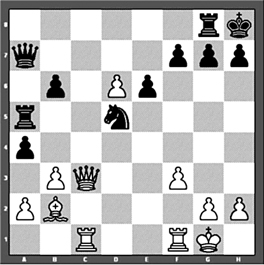
| NEWS |
| |
| FEATURES |
| ENTERTAINMENT |
| COLUMNS |
| CONTACT US |
| HOW TO SUBMIT |
| BACK ISSUES |
Double Fianchetto
Chad Lieberman
There is a lot of attention today being paid to the fianchetto and its advantages. The Accelerated Dragon defense in the plethora of Sicilian systems has led the surge in popularity of developing one's bishop to the knight's file.
In this week's featured game, Mr. Dudas attempts to reveal the power of the double fianchetto, positioning his bishops to oversee the long diagonals. Although he eventually succeeds, the game is less than perfect.
This opening was popular during the four decades from the 1950's through the 1980's when players were studying the discoveries of Aron Nimzovich and the beginnings of hypermodernism. Since 1987, this opening has rarely been used.
If you play through the game, you will notice that the opening is characterized by the exchange of squares. Black seemingly offers white a home in d6 while he conquers d4. These two squares guide the players' actions for the first dozen moves.
White finally initiates the battle with the space-grabbing and knight-evicting 13.g4. After a series of exchanges it becomes obvious that white has all of the advantages of a dynamic position while black needs to quickly protect his king.
If a player wishes to capitalize on such an advantage, he or she must act immediately and with authority. Dudas's 19.a3?! is less than adequate. Instead, 19.a4! initiates an attack from which black would probably not recover. The continuation might have been 19...Na5 20.Ba3 Qc7 21.b4 Bxg2 22.Qxg2 Nb7 23.a5! and black's queenside is destroyed.
Instead, white attempted to steadily build his attack and gave black a chance to fight back with 20...e5! 21.f5 h5 when the site of the battle has gone east to the kingside. Black played 20...g5? and after a series of trades, he was left in a strait jacket.

White to mate in two moves.
Link to solution at the bottom.
Dudas, P. (2125) - Kormos, L.
(2175) | |
| 1.e4 | c5 |
| 2.b3 | Nf6 |
| 3.e5 | Nd5 |
| 4.Bb2 | e6 |
| 5.Nf3 | a6 |
| 6.c4 | Ne7 |
| 7.Nc3 | Nbc6 |
| 8.g3 | Qc7 |
| 9.Qe2 | Nf5 |
| 10.Ne4 | b6 |
| 11.Bg2 | Bb7 |
| 12.0-0 | Be7 |
| 13.g4 | Nfd4 |
| 14.Nxd4 | cxd4 |
| 15.f4 | d6 |
| 16.exd6 | Bxd6 |
| 17.Nxd6+ | Qxd6 |
| 18.d3 | 0-0-0 |
| 19.a3 | Rhe8 |
| 20.b4 | g5 |
| 21.fxg5 | Qe7 |
| 22.Rf6 | Rg8 |
| 23.h4 | Rd7 |
| 24.Raf1 | Rg7 |
| 25.Bc1 | Kb8 |
| 26.Rh6 | Ka7 |
| 27.Be4 | Rd8 |
| 28.Bf4 | Qd7 |
| 29.b5 | axb5 |
| 30.cxb5 | Ne7 |
| 31.Bxb7 | Qxb7 |
| 32.Qc2 | Ka8 |
| 33.Qa4+ | Qa7 |
| 34.Qxa7+ | Kxa7 |
| 35.Be5 | Black resigns |